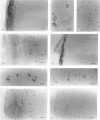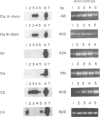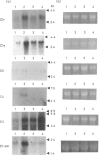Abstract
Using immunohistochemical studies, C1q, C1s, C4 and C2 were detected in chondrocytes in normal human articular cartilage and macroscopically normal articular cartilage from the inferior surfaces of hip joints of patients with osteoarthritis. Using reverse-transcribed polymerase chain reaction (RT-PCR), mRNA for C1q, C1s, C4 and C2 was also detected in RNA extracted from articular cartilage. C1r, C3, C1-inhibitor, C4-binding protein and factor I were not detected by either technique. Articular chondrocytes cultured in vitro synthesized C1r, C1s, C4, C2, C3 and C1-inhibitor but not C1q, C4-binding protein or factor I, as assessed by enzyme-linked immunosorbent assay (ELISA) and Northern blot analysis. Thus cultured articular chondrocytes have a complement profile that is similar to that of cultured human fibroblasts rather than that of articular chondrocytes in vivo. Complement synthesis in cultured chondrocytes was modulated by the cytokines interleukin-1 beta (IL-1 beta), tumour necrosis factor-alpha (TNF-alpha) and interferon-gamma (IFN-gamma), showing that cytokines can probably regulate complement synthesis in intact cartilage. The possible roles of local synthesis of complement components by chondrocytes in matrix turnover and the regulation chondrocyte function are discussed.
Full text
PDF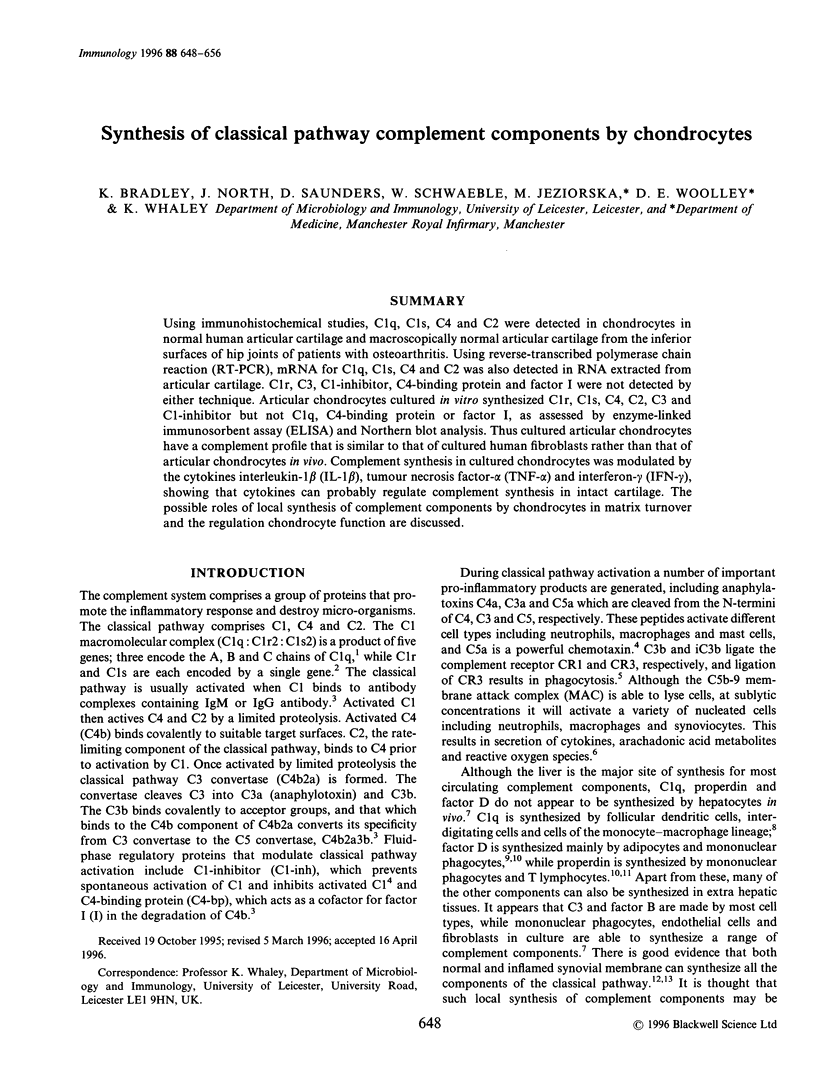
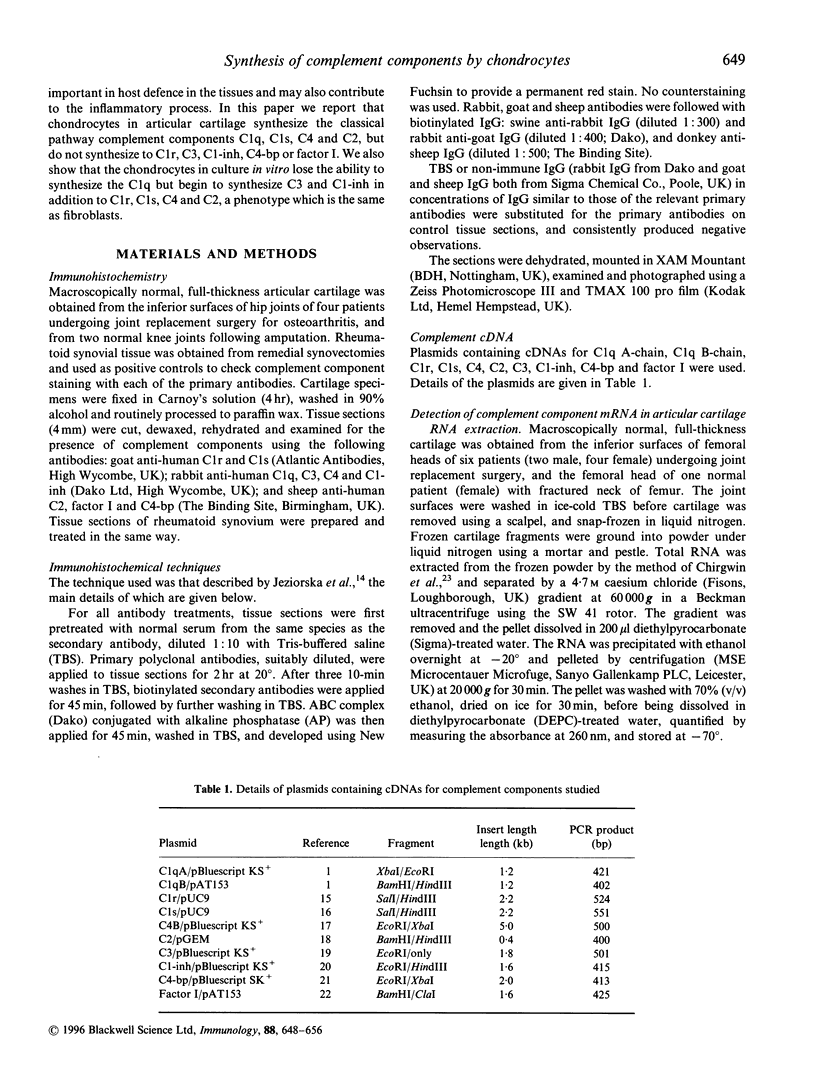
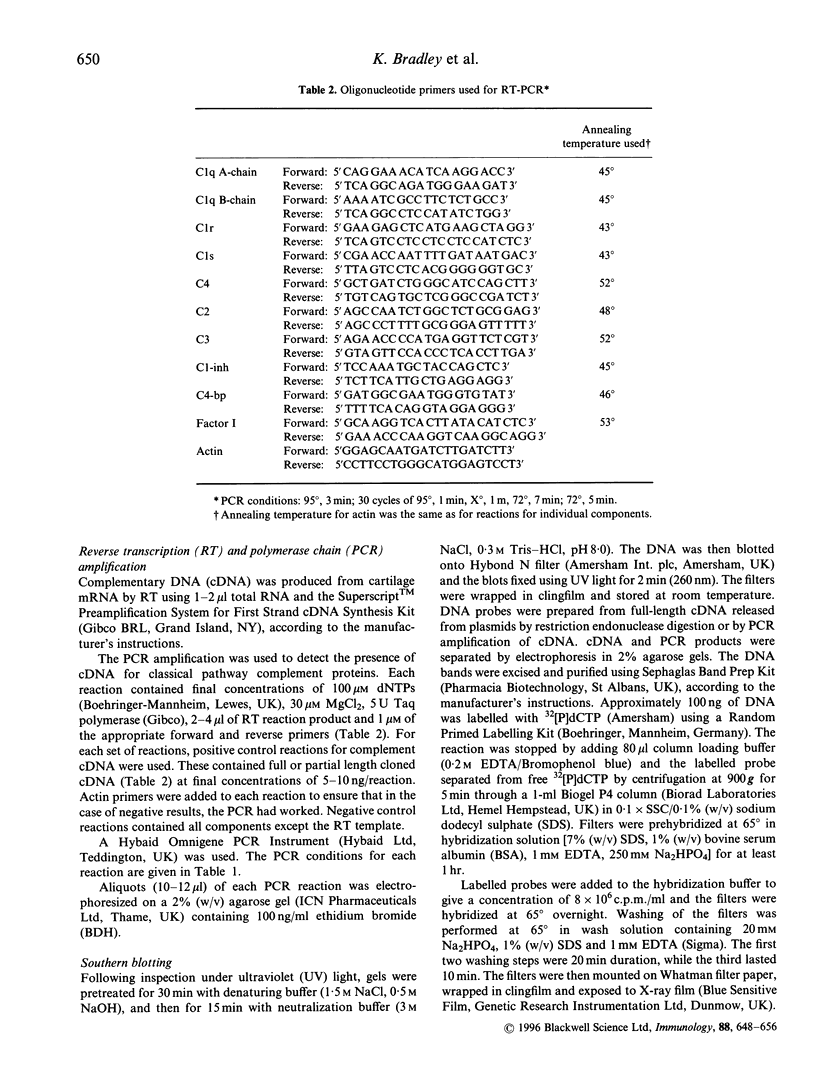
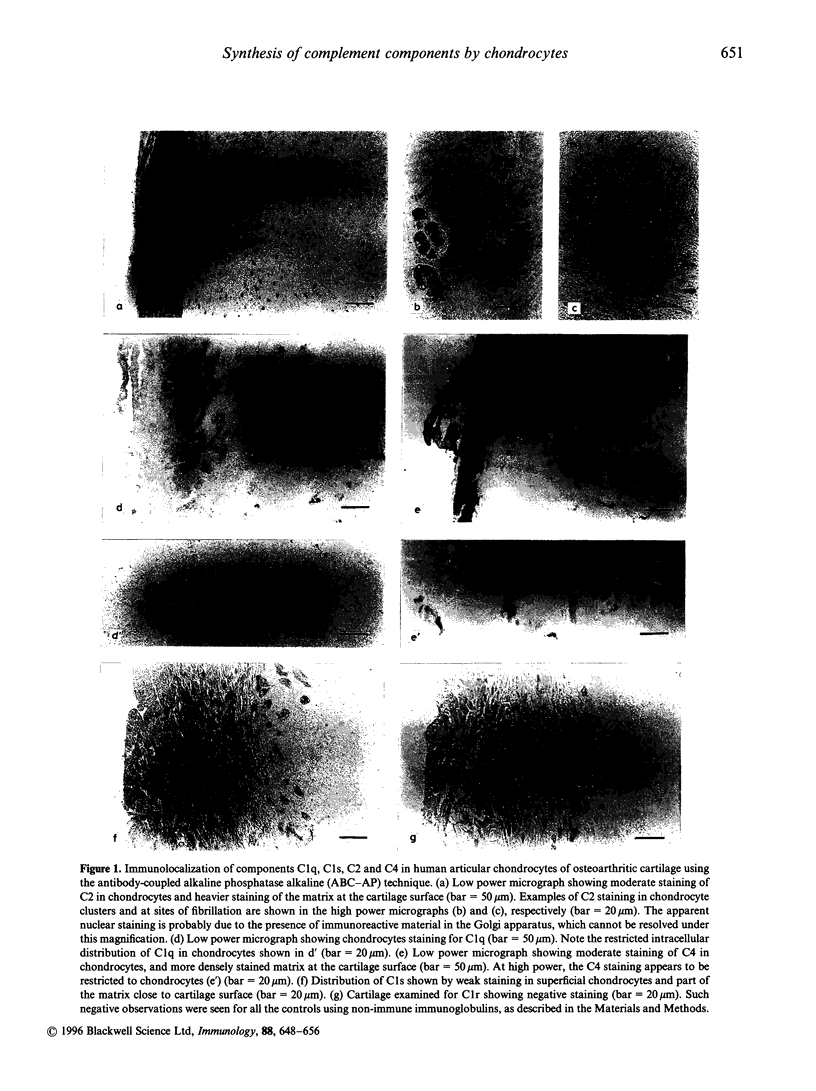
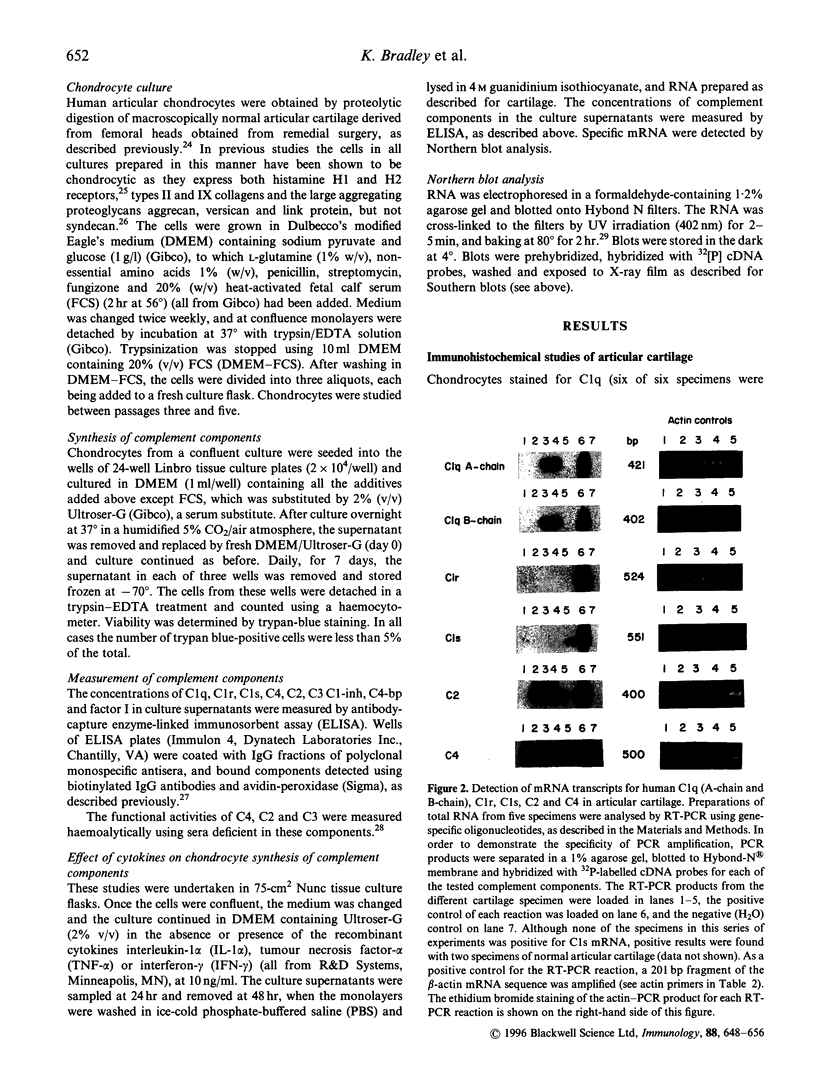
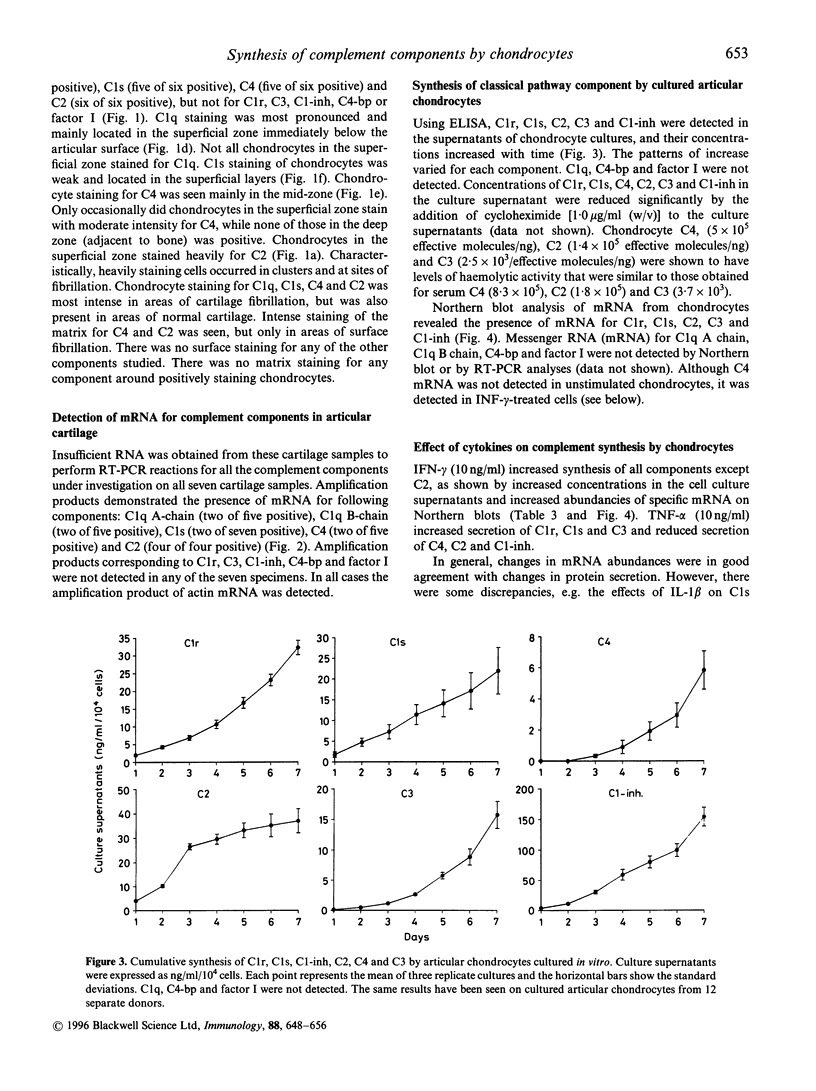
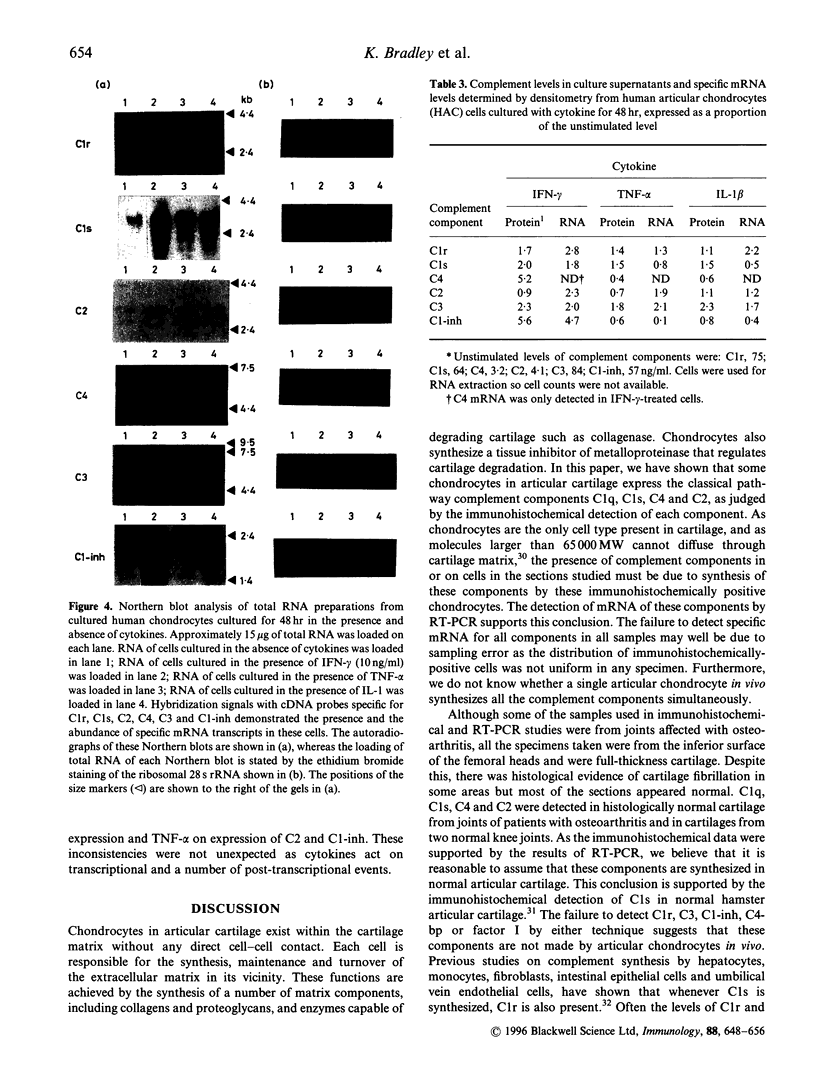
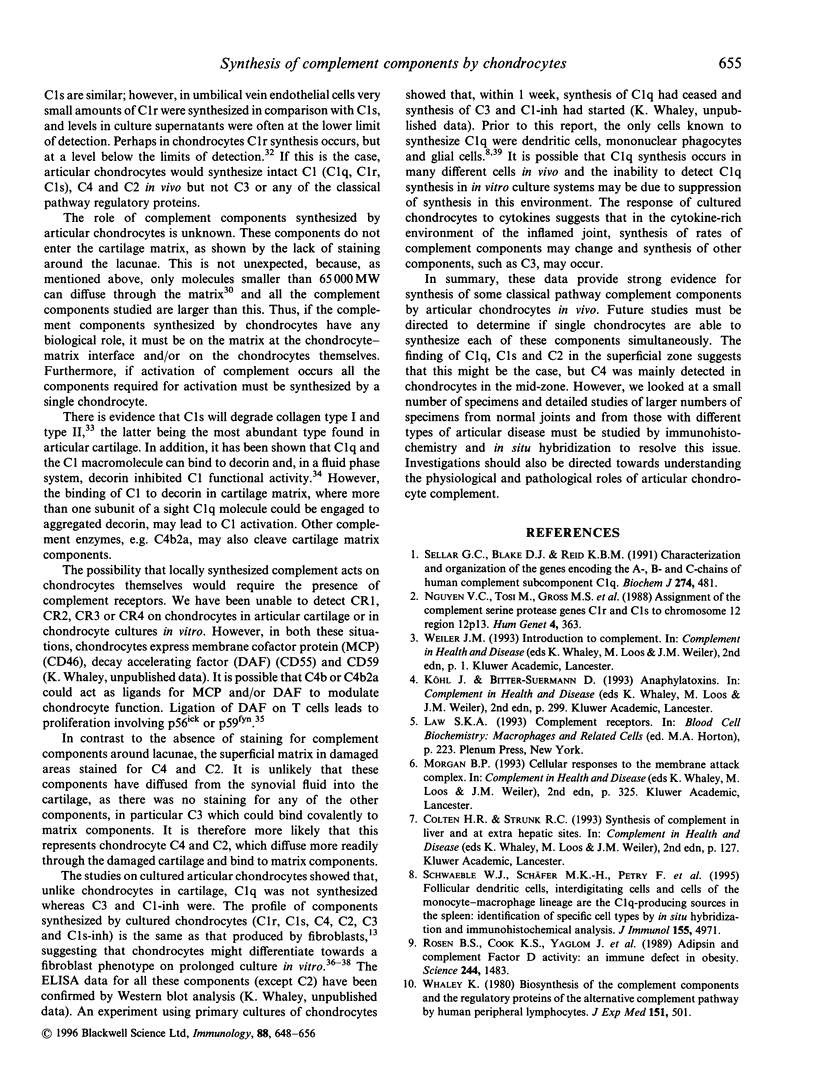
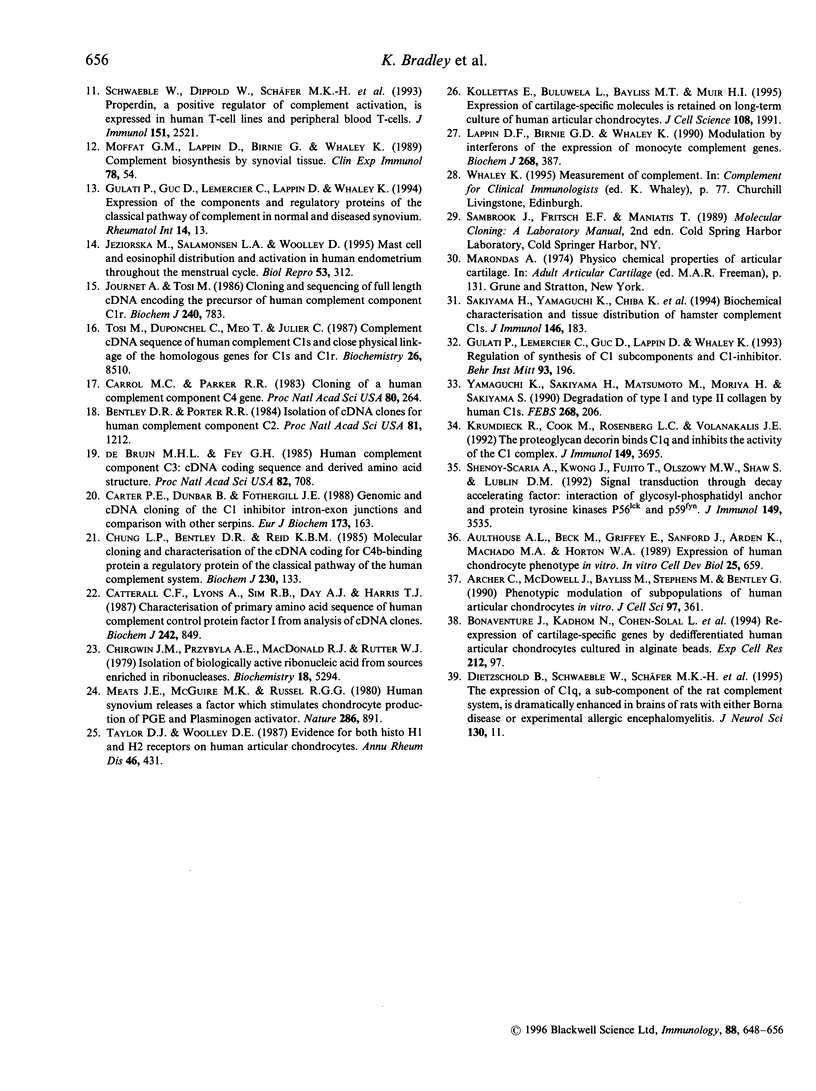
Images in this article
Selected References
These references are in PubMed. This may not be the complete list of references from this article.
- Archer C. W., McDowell J., Bayliss M. T., Stephens M. D., Bentley G. Phenotypic modulation in sub-populations of human articular chondrocytes in vitro. J Cell Sci. 1990 Oct;97(Pt 2):361–371. doi: 10.1242/jcs.97.2.361. [DOI] [PubMed] [Google Scholar]
- Aulthouse A. L., Beck M., Griffey E., Sanford J., Arden K., Machado M. A., Horton W. A. Expression of the human chondrocyte phenotype in vitro. In Vitro Cell Dev Biol. 1989 Jul;25(7):659–668. doi: 10.1007/BF02623638. [DOI] [PubMed] [Google Scholar]
- Bentley D. R., Porter R. R. Isolation of cDNA clones for human complement component C2. Proc Natl Acad Sci U S A. 1984 Feb;81(4):1212–1215. doi: 10.1073/pnas.81.4.1212. [DOI] [PMC free article] [PubMed] [Google Scholar]
- Bonaventure J., Kadhom N., Cohen-Solal L., Ng K. H., Bourguignon J., Lasselin C., Freisinger P. Reexpression of cartilage-specific genes by dedifferentiated human articular chondrocytes cultured in alginate beads. Exp Cell Res. 1994 May;212(1):97–104. doi: 10.1006/excr.1994.1123. [DOI] [PubMed] [Google Scholar]
- Carroll M. C., Porter R. R. Cloning of a human complement component C4 gene. Proc Natl Acad Sci U S A. 1983 Jan;80(1):264–267. doi: 10.1073/pnas.80.1.264. [DOI] [PMC free article] [PubMed] [Google Scholar]
- Carter P. E., Dunbar B., Fothergill J. E. Genomic and cDNA cloning of the human C1 inhibitor. Intron-exon junctions and comparison with other serpins. Eur J Biochem. 1988 Apr 5;173(1):163–169. doi: 10.1111/j.1432-1033.1988.tb13980.x. [DOI] [PubMed] [Google Scholar]
- Catterall C. F., Lyons A., Sim R. B., Day A. J., Harris T. J. Characterization of primary amino acid sequence of human complement control protein factor I from an analysis of cDNA clones. Biochem J. 1987 Mar 15;242(3):849–856. doi: 10.1042/bj2420849. [DOI] [PMC free article] [PubMed] [Google Scholar]
- Chirgwin J. M., Przybyla A. E., MacDonald R. J., Rutter W. J. Isolation of biologically active ribonucleic acid from sources enriched in ribonuclease. Biochemistry. 1979 Nov 27;18(24):5294–5299. doi: 10.1021/bi00591a005. [DOI] [PubMed] [Google Scholar]
- Chung L. P., Bentley D. R., Reid K. B. Molecular cloning and characterization of the cDNA coding for C4b-binding protein, a regulatory protein of the classical pathway of the human complement system. Biochem J. 1985 Aug 15;230(1):133–141. doi: 10.1042/bj2300133. [DOI] [PMC free article] [PubMed] [Google Scholar]
- Dietzschold B., Schwaeble W., Schäfer M. K., Hooper D. C., Zehng Y. M., Petry F., Sheng H., Fink T., Loos M., Koprowski H. Expression of C1q, a subcomponent of the rat complement system, is dramatically enhanced in brains of rats with either Borna disease or experimental allergic encephalomyelitis. J Neurol Sci. 1995 May;130(1):11–16. doi: 10.1016/0022-510x(94)00269-t. [DOI] [PubMed] [Google Scholar]
- Gulati P., Lemercier C., Guc D., Lappin D., Whaley K. Regulation of the synthesis of C1 subcomponents and C1-inhibitor. Behring Inst Mitt. 1993 Dec;(93):196–203. [PubMed] [Google Scholar]
- Jeziorska M., Salamonsen L. A., Woolley D. E. Mast cell and eosinophil distribution and activation in human endometrium throughout the menstrual cycle. Biol Reprod. 1995 Aug;53(2):312–320. doi: 10.1095/biolreprod53.2.312. [DOI] [PubMed] [Google Scholar]
- Journet A., Tosi M. Cloning and sequencing of full-length cDNA encoding the precursor of human complement component C1r. Biochem J. 1986 Dec 15;240(3):783–787. doi: 10.1042/bj2400783. [DOI] [PMC free article] [PubMed] [Google Scholar]
- Kolettas E., Buluwela L., Bayliss M. T., Muir H. I. Expression of cartilage-specific molecules is retained on long-term culture of human articular chondrocytes. J Cell Sci. 1995 May;108(Pt 5):1991–1999. doi: 10.1242/jcs.108.5.1991. [DOI] [PubMed] [Google Scholar]
- Krumdieck R., Hök M., Rosenberg L. C., Volanakis J. E. The proteoglycan decorin binds C1q and inhibits the activity of the C1 complex. J Immunol. 1992 Dec 1;149(11):3695–3701. [PubMed] [Google Scholar]
- Lappin D. F., Birnie G. D., Whaley K. Modulation by interferons of the expression of monocyte complement genes. Biochem J. 1990 Jun 1;268(2):387–392. doi: 10.1042/bj2680387. [DOI] [PMC free article] [PubMed] [Google Scholar]
- Meats J. E., McGuire M. B., Russell R. G. Human synovium releases a factor which stimulates chondrocyte production of PGE and plasminogen activator. Nature. 1980 Aug 28;286(5776):891–892. doi: 10.1038/286891a0. [DOI] [PubMed] [Google Scholar]
- Moffat G. J., Lappin D., Birnie G. D., Whaley K. Complement biosynthesis in human synovial tissue. Clin Exp Immunol. 1989 Oct;78(1):54–60. [PMC free article] [PubMed] [Google Scholar]
- Nguyen V. C., Tosi M., Gross M. S., Cohen-Haguenauer O., Jegou-Foubert C., de Tand M. F., Meo T., Frézal J. Assignment of the complement serine protease genes C1r and C1s to chromosome 12 region 12p13. Hum Genet. 1988 Apr;78(4):363–368. doi: 10.1007/BF00291737. [DOI] [PubMed] [Google Scholar]
- Rosen B. S., Cook K. S., Yaglom J., Groves D. L., Volanakis J. E., Damm D., White T., Spiegelman B. M. Adipsin and complement factor D activity: an immune-related defect in obesity. Science. 1989 Jun 23;244(4911):1483–1487. doi: 10.1126/science.2734615. [DOI] [PubMed] [Google Scholar]
- Sakiyama H., Yamaguchi K., Chiba K., Nagata K., Taniyama C., Matsumoto M., Suzuki G., Tanaka T., Tomoasawa T., Yasukawa M. Biochemical characterization and tissue distribution of hamster complement C1s. J Immunol. 1991 Jan 1;146(1):183–187. [PubMed] [Google Scholar]
- Schwaeble W., Dippold W. G., Schäfer M. K., Pohla H., Jonas D., Luttig B., Weihe E., Huemer H. P., Dierich M. P., Reid K. B. Properdin, a positive regulator of complement activation, is expressed in human T cell lines and peripheral blood T cells. J Immunol. 1993 Sep 1;151(5):2521–2528. [PubMed] [Google Scholar]
- Schwaeble W., Schäfer M. K., Petry F., Fink T., Knebel D., Weihe E., Loos M. Follicular dendritic cells, interdigitating cells, and cells of the monocyte-macrophage lineage are the C1q-producing sources in the spleen. Identification of specific cell types by in situ hybridization and immunohistochemical analysis. J Immunol. 1995 Nov 15;155(10):4971–4978. [PubMed] [Google Scholar]
- Sellar G. C., Blake D. J., Reid K. B. Characterization and organization of the genes encoding the A-, B- and C-chains of human complement subcomponent C1q. The complete derived amino acid sequence of human C1q. Biochem J. 1991 Mar 1;274(Pt 2):481–490. doi: 10.1042/bj2740481. [DOI] [PMC free article] [PubMed] [Google Scholar]
- Shenoy-Scaria A. M., Kwong J., Fujita T., Olszowy M. W., Shaw A. S., Lublin D. M. Signal transduction through decay-accelerating factor. Interaction of glycosyl-phosphatidylinositol anchor and protein tyrosine kinases p56lck and p59fyn 1. J Immunol. 1992 Dec 1;149(11):3535–3541. [PubMed] [Google Scholar]
- Taylor D. J., Woolley D. E. Evidence for both histamine H1 and H2 receptors on human articular chondrocytes. Ann Rheum Dis. 1987 Jun;46(6):431–435. doi: 10.1136/ard.46.6.431. [DOI] [PMC free article] [PubMed] [Google Scholar]
- Whaley K. Biosynthesis of the complement components and the regulatory proteins of the alternative complement pathway by human peripheral blood monocytes. J Exp Med. 1980 Mar 1;151(3):501–516. doi: 10.1084/jem.151.3.501. [DOI] [PMC free article] [PubMed] [Google Scholar]
- Yamaguchi K., Sakiyama H., Matsumoto M., Moriya H., Sakiyama S. Degradation of type I and II collagen by human activated C1-s. FEBS Lett. 1990 Jul 30;268(1):206–208. doi: 10.1016/0014-5793(90)81009-d. [DOI] [PubMed] [Google Scholar]
- de Bruijn M. H., Fey G. H. Human complement component C3: cDNA coding sequence and derived primary structure. Proc Natl Acad Sci U S A. 1985 Feb;82(3):708–712. doi: 10.1073/pnas.82.3.708. [DOI] [PMC free article] [PubMed] [Google Scholar]



